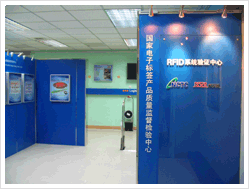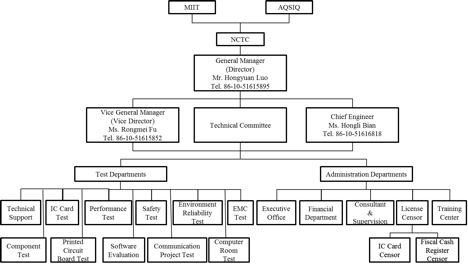2013-01-14 by Dr. Xin Song, Leonard Zuga, and Professor Michael Pecht
National Computer Quality Supervising Test Center and China’s Dual-Use Industrial Base
The National Computer Quality Supervising Test Center (NCTC) was established under the authorization of the General Administration of Quality Supervision, Inspection, and Quarantine (AQSIQ)[1] and the Ministry of Industry and Information Technology (MIIT)[2] in the People’s Republic of China.
Under the authorization of AQSIQ, MIIT, and the National Gold Card Office, the objective of NCTC is to promote national industrial scientific and technological development.
The NCTC provides national-level test services on products such as computers, computer peripherals, computer network equipment, fiscal cash registers, second generation identity card reading (verification) equipment, computer room equipment and engineering, printed circuit boards, electronic components, integrated network cabling, software, integrated circuit (IC) cards and equipment, radio frequency identification (RFID) and equipment, and energy-saving computers.

To keep up with developments in the nation’s information industry, NCTC founded a series of test centers, including the Machinery Electronics Industry Computer Room Device Quality Supervising Test Center, MIIT IC Card Quality Supervising Test Center, and National Radio Frequency Identification (RFID) Product Quality Supervising Test Center.
The major test types provided by NCTC include Entrusted Inspection, Arbitration Inspection, Quality State Monitor Selective Testing, Production License Validation Testing, China Compulsory Product Certification (CCC or 3C) Authentication, and Certification for Energy-Saving.
The corporate entity of NCTC is Beijing Zunguan Science Technology Ltd. (Beijing Zunguan).
Beijing Zunguan was approved by the China National Accreditation Board for Laboratories (CNAL) and authorized by the AQSIQ and MIIT to carry out national-level inspection and assessment of electronic product quality as a third party.
The China Electronics Technology Group Corporation’s (CETC) 15th Institute and the China Information Industry Trade Association (CIITA)[3] hold shares in NCTC of 80% and 20%, respectively.
In the following discussion of the CETC’s 15th Institute, we see the historical development of a close relationship between the defense and commercial electronics sectors.
The CETC’s 15th Institute
The 15th Institute of the China Electronics Technology Group Corporation (CETC) provides technical and personnel support to the NCTC, thereby serving as the technical base for the NCTC. The 15th Institute is not only the leader in the design and construction of China’s national information systems, but it is also one of the largest system integrators in China.
The 15th Institute provides computer systems for national defense and economic development.
The 15th Institute was founded in 1958. In addition to the 15th Institute, CETC today consists of 50 other institutes, each of which is an individual entity. Overall, the CETC has responsibilities in specialized areas of product development (including providing technology solutions), technology research, graduate student education, and manufacturing. Product development used to be the main income source for the CETC’s 51 institutes.
However, many of them have started to provide testing services, which have become one of the major revenue sources. Additionally, many CETC institutes have also entered the civilian product market by founding new spinoff companies.
The objective of the 15th Institute itself is to provide the defense industry with computing technology and products.
It developed China’s first computer in 1959 and China’s first large general-purpose computer in the 1970s. It has been active in many critical projects, such as the launch of China’s first satellite in 1970, the launch of an inter-continental missile into the South Pacific Ocean in 1980, and the launch of the first Shenzhou space shuttle in 1999.
In 1987, the 15th Institute entered the civilian computer product market with the registration of a company named Taiji Computer Corporation Limited. With the establishment of the NCTC, the 15th Institute has been carrying out national-level computer product supervision.
Historical Evolution of the NCTC
There have been three stages in the development of the NCTC: establishment, expansion, and registration.
Stage One
The first stage, establishment, began in the early 1980s, when industrial products in China suffered a drop in quality. Beginning in 1985, the State Council of China decided to carry out national quality supervision inspection for industrial products and authorized the China State Bureau of Technology Supervision (CSBTS) to organize the establishment of national-level product quality supervision centers.
As the first step, in 1986, the Ministry of the Electronics Industry (the forerunner of the Ministry of the Information Industry, currently MIIT) authorized the 15th Institute to establish the Quality Test Center for Electronic Industry Computer Products and Printed Circuit Boards, which was the forerunner of the NCTC. In 1987, the CSBTS decided to establish a national-level computer quality supervision and test center in the 15th Institute, and the National Commodity Inspection Bureau also decided to establish a national-level computer product inspection lab in the 15th Institute.
NCTC was founded to meet these demands, and it was authorized as a national-level supervision and test center in 1993. At this stage, its business focus was inspection and testing for computers, computer peripheral equipment, integrated circuit cards, and integrated circuit card machines.
Stage Two
In the second expansion stage, NCTC proposed to register a series of test centers to expand its services in a variety of electronic products at different locations around the country. The proposal was approved, and various supervision and test centers were registered in the 1990s.
These centers share the same staff. At this time, NCTC’s business responsibilities were expanded to include information security. NCTC consists of the following major test centers:
National-level centers[4]:
- National Electronic Tag Product Quality Supervising Test Center
- Information Industry Computer Product Quality Supervising Test Center
- Information Industry Computer Room Engineering and Equipment Quality Supervising Test Center
- Information Industry Information Security Test Center
Ministry-level centers:
- Information Industry Printed Circuit Board Quality Supervising Test Center
- Information Industry IC Card Quality Supervising Test Center
In China, national-level centers are authorized by national-level bureaus, such as AQSIQ, which report directly to the State of Council. Ministry-level centers are authorized by ministry-level bureaus, such as the bureaus reporting to the Ministry of the Electronics Industry.
A product certified by a national-level center usually can be accepted universally by any customer in China. A product which is only certified by a ministry-level center might not be acceptable to customers who require that products be certified by higher level certification (i.e., national-level certification).
Stage Three
In the late 1990s, the State Quality Supervision Bureau determined that the third-party inspection agency should be an independent legal entity. Therefore, NCTC entered into a third stage of development, registration, where it became a company with a separate legal entity: Beijing Zunguan Information Technology Products Quality Inspection Authentication Ltd. in 2001, and then Beijing Zunguan Science Technology Company Ltd. in 2003.
This company was established as a joint venture between the 15th Institute and the China Information Industry Trade Association, although the NCTC still belongs to the 15th Institute administratively. During this time, NCTC further expanded its business areas into finance and social security.
Organization of the NCTC
As previously mentioned, the NCTC is a subsidiary unit of the 15th Institute, which is one of 51 institutes under the China Electronics Technology Group Corporation (CETC), a government-controlled company.
The CETC reports to AQSIQ and MIIT directly, as shown in the organizational chart in Figure 1. Even though the NCTC is registered as an independent legal entity, it has strong ties with the Chinese government.
Its parent unit (the 15th Institute) is responsible for significant government projects and the majority of the government projects taken by the NCTC. The key NCTC personnel, along with their areas of authority, are summarized Figure 1 and in the following paragraph.
Figure 1. NCTC organizational chart.[5]
Hongyuan Luo (罗洪元), Director and General Manager of NCTC. Mr. Luo graduated from the department of mathematics standards. Hongyuan Luo is a standing council member of the China Computer Industry Association, vice chairman of the Council of China RFID Alliance, vice leader of the RFID Working Group Application Team of the Electronic Label Ministry of Industry and Information Technology, and vice director of the National Technical Committee on Digital Techniques of Intelligent Building and Residence Community of the Standardization Administration of China
Rongmei Fu (符荣梅), Vice Director and General Manager of NCTC. Ms. Fu has been working in the area of electromagnetic compatibility (EMC), safety, and reliability for computers. She has published several research papers in EMC testing. Ms. Fu has responsibility and authority over performance, safety, environment, EMC, reliability of IT equipment and systems, IC cards and IC card read and write devices, RFID products, digital television systems, fiscal cash registers; testing of computer rooms, cabling systems, and software products
Hongli Bian (边红丽), Chief Engineer of NCTC. Ms. Bian oversees all areas of testing and promotes those areas that are emphasized by the government to better serve clients of the NCTC.
About the Authors:
Dr. Xin Song, the primary Chinese linguist for this research, is a hydrogeologist and environmental engineer. Dr. Song graduated holds a Master degree in Environmental Science from Tsinghua University, Beijing and a PhD in Civil and Environmental Engineering from University of Maryland, College Park.
Leonard Zuga is an analyst of emerging technologies, technology transfer, and industrial base development in the context of the global political economy.
Professor Michael Pecht is the founder and Director of CALCE (Center for Advanced Life Cycle Engineering) at the University of Maryland, which is funded by over 150 of the world’s leading electronics companies at more than US$6M/year. The CALCE Center received the NSF Innovation Award in 2009.
Editor’s Note: The report on the NCTC will be published in four parts and then available in a single downloadable report after publication of the final part.
[1] The AQSIQ is a ministerial-level administrative department directly under the State Council of the People’s Republic of China and is in charge of national quality, metrology, entry-exit commodity inspection, entry-exit health quarantine, entry-exit animal and plant quarantine, import-export food safety, certification and accreditation, and standardization, as well as administrative law-enforcement. AQSIQ was formed by merging the CSBTS and the former State Bureau of Import & Export Inspection and Quarantine in 2001; at the same time, the Standardization Administration of the People’s Republic of China (SAC) and Certification and Accreditation Administration of the People’s Republic of China (CNCA) were established under AQSIQ.
[2] The MIIT, formerly the Ministry of Information Industry, was established by the State Council in March 2008 to incorporate the functions of several previous ministries and offices, including the ministry-level Commission of Science, Technology, and Industry for National Defense (COSTIND), the State Council Information Office, the State Tobacco Monopoly Bureau, and the National Development and Reform Commission (NDRC). The MIIT also includes the subordinate State Bureau for Science, Technology, and Industry for National Defense, which is responsible for the management of defense, shipbuilding, and aerospace industries—previous functions of COSTIND. MIIT is responsible for the regulation and development of the postal service, internet, wireless, broadcasting, communications, production of electronic and information goods, software industry, and promotion of the national economy.
[3] The China Information Industry Trade Association (CIITA) is a national non-profit organization associated with the information industry in China. Under the guidance and supervision of the MIIT, CIITA was founded in May 1990 to develop information resources and expand the information market, as well as to develop electronic information in China.
[4] There is no official translation for the names of these centers, which suggests that there is no intent to market to foreigners.
[5] There are two units mentioned in this discussion that are not shown in Figure 1: The 15th institute and CETC. NTC, as portrayed in Figure 1, is an independent legal entity that reports directly to AQSIQ and MIIT. This is the organizational chart within NCTC.


